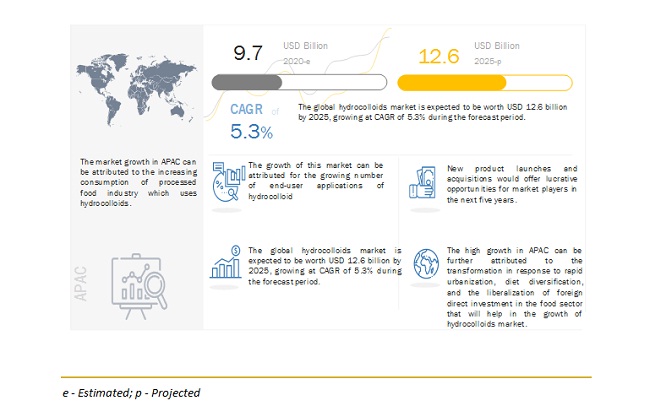The global hydrocolloids market was valued at USD 9.7 billion in 2020 and is projected to reach USD 12.6 billion by 2025, at a CAGR of 5.3%. The growth of the hydrocolloids market is driven by factors such as the expansion of the processed food industry due to the increasing demand for convenience foods in regions such as the Asia Pacific, South America, and the Middle East & African. Apart from this, manufacturers are engaged in R&D to offer high-quality hydrocolloids due to its multi-functionality in the food industry.
The key players in the hydrocolloids market include Dupont (US), Ingredion (US), Cargill (US), Kerry (Ireland), Archer Daniels Midland Company (US), Palsgaard (Denmark), Darling Ingredients (US), CP Kelco (US), Ashland (US), BASF (Germany), Tate & Lyle (UK), Glanbia (Ireland), Fuerst Day Lawson (UK), Koninklijke DSM N.V (Netherlands), and Nexira (France) are the players that hold a significant share in the hydrocolloids market.

Download PDF brochure: https://www.marketsandmarkets.com/pdfdownloadNew.asp?id=1231
Market Dynamics
Driver: Rise in Consumption of Premium Food & Beverage Products
The increase in consumer preference for convenience foods indirectly contributes to the rise in demand for hydrocolloids required as stabilizers, texturants, binding agents, viscosity, and thickening agents in these convenience food products. The processed food market is driven by the greater need for convenience due to the busy lifestyles of consumers. This, in turn, increases the demand for hydrocolloids. The hydrocolloids industry has a positive outlook due to high growth in the food processing industry. A leading food journal estimates that about 35% of the American population consumes at least three prepared convenience food products in a week, and this is projected to grow to about 40% of the population in the future.
Restraint: Stringent International Quality Standards and Regulations
International bodies such as the National Food Safety and Quality Service (SENASA), Canadian Food Inspection Agency (CFIA), US Food and Drug Administration (FDA), World Health Organization (WHO), and Committee on the Environment, Public Health and Food Safety (EU) are associated with food safety regulations. These organizations have control over the usage of different chemicals and materials used in food & beverage processing, directly or indirectly. With stringent international regulations, regulatory approval of a food & beverage ingredient is critical. Without approval from the appropriate government bodies, the additive has no market or function in food. Obtaining regulatory approval for a new ingredient is becoming increasingly expensive and a time-consuming process.
Opportunity: Increase in Investments in Research & Development
Hydrocolloids are largely utilized in processed and convenience foods. These products require food additives such as hydrocolloids that impart proper texture, viscosity, mouthfeel, and shape to the food. The wide application of hydrocolloids in food has led to the introduction of new procedures or complex steps in food processing. Food manufacturers are adopting sophisticated food processing methods and are demanding new hydrocolloids that can impart the desired functions.
Challenge: Unclear Labeling Leading to Ambiguity and Uncertainty
The issue of food labeling in the hydrocolloids industry is similar to that in the entire food industry, including regulatory environments and health concerns that are demanding more comprehensive labeling. In Europe, regulations have been introduced on the labeling of foodstuffs to enable European consumers to gain information regarding composition, manufacturer, storage methods, and preparation. Consumers are now becoming more aware of their right to information. They demand full information of the ingredients present in the food products.
Request for Customization: https://www.marketsandmarkets.com/requestCustomizationNew.asp?id=1231
The North America is projected to account for the largest market share during the forecast period
North America is a dominant region in the global hydrocolloids market. Factors influencing its market dominance include the high demand for functional dairy products, convenience foods, higher per capita consumption of baked goods, and presence of major players. Consumers in the US are calorie-conscious due to which low-calorie and low-fat foods are popular in the country. The increasing prevalence of obesity and cardiac diseases has led consumers to demand natural and low-calorie food products. Food manufacturers are therefore concentrating on the application of natural hydrocolloids and their function as fat replacers
The gelatin segment is estimated to be the largest segment The hydrocolloids market, by type, is estimated to be dominated by the gelatin segment. The usage of gelatin as a gelling agent is projected to grow due to the increasing need for emulsifiers in the food & beverage industry in major markets such as Germany, the UK, and France. It is commonly used in candies, desserts, marshmallows, and ice creams. Gelatin functions as a texturant, gelling agent; it releases flavor and imparts proper mouthfeel to food products.